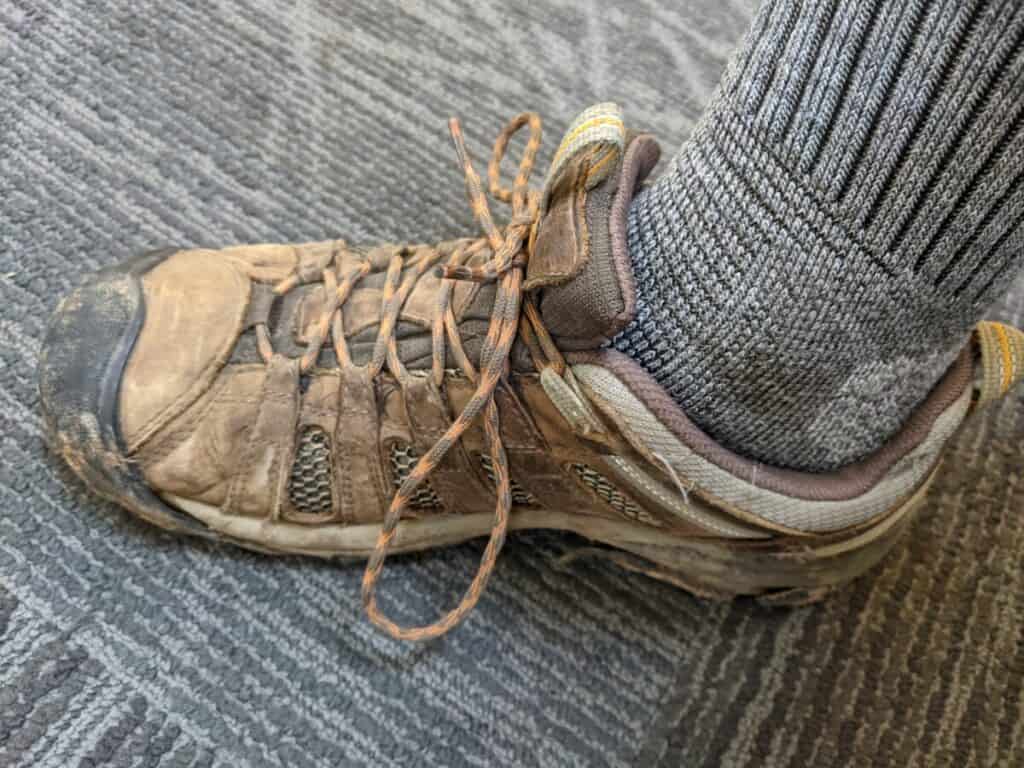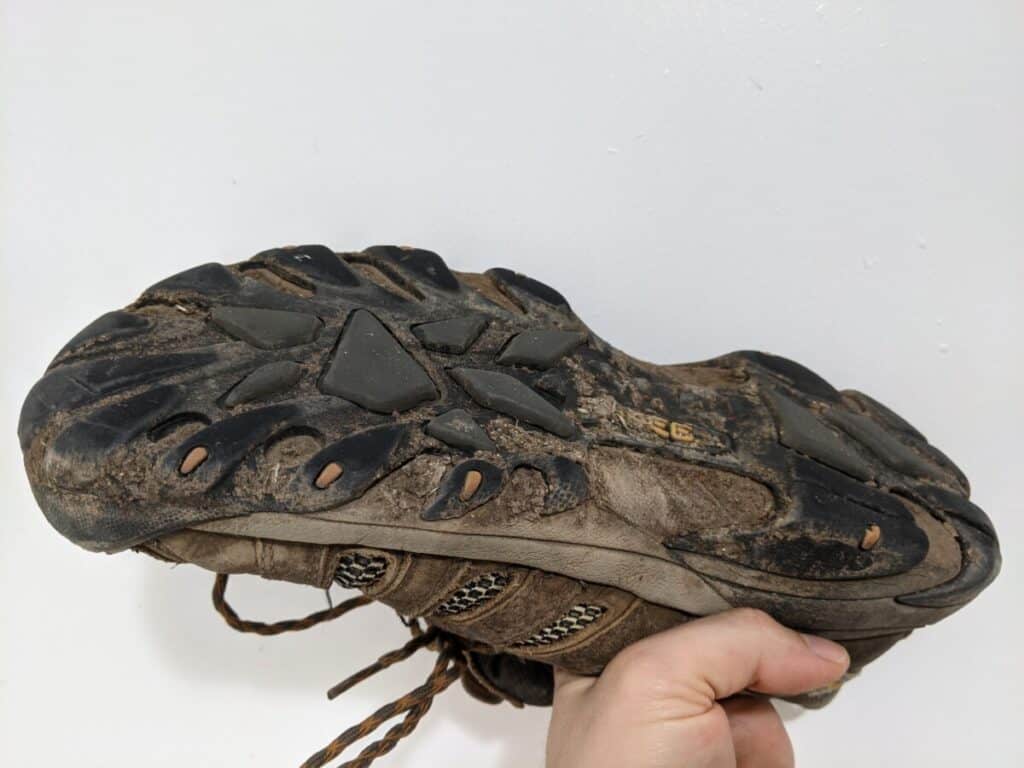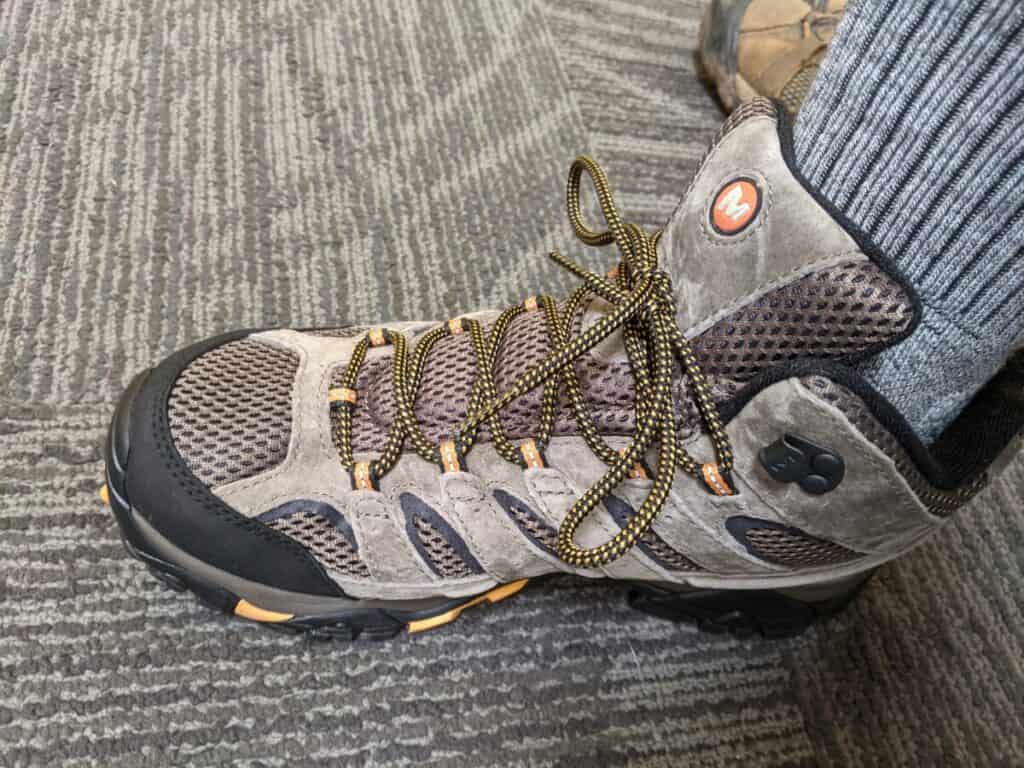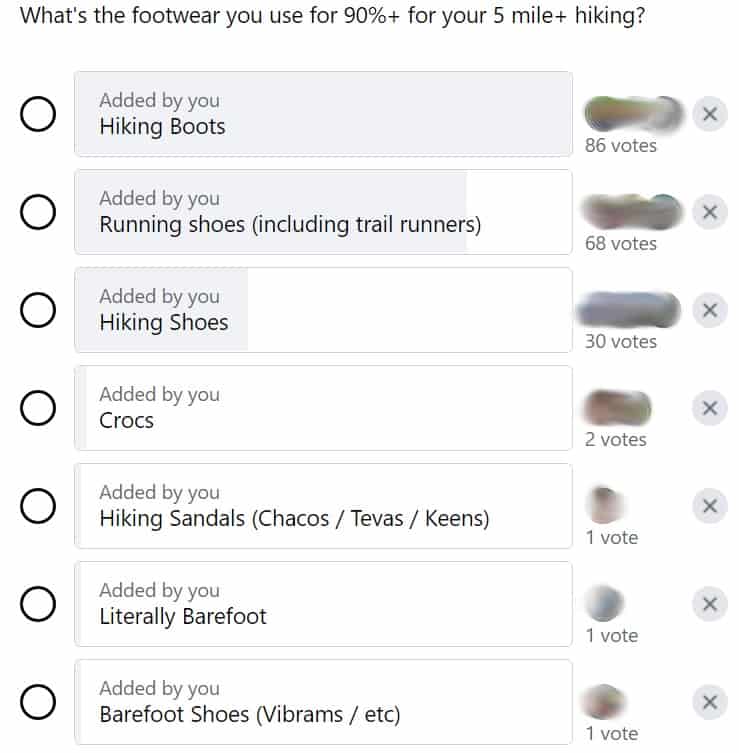While hiking shoes can be used for casual walking, there are some specific pros and cons to doing so. For example, they provide better ankle and arch support, but also a lower comfort level. They are of course not made for everyday walking. But can you? In this article, we will explore why you would or would not choose to wear your hiking shoes daily.
Although hiking shoes and boots are for walking over rough terrain, they can be used to walk on the street or in casual circumstances. Walking in hiking shoes can even provide more support. However, hiking shoes are heavier and bulkier than regular shoes and can wear out faster with casual use.
Because of their designs, hiking shoes and boots are drastically different than the normal walking shoe. For that reason, it is really up to you to decide if you want to wear your hiking shoes for walking.
By the way, as an Amazon Associate, I earn when buying qualified products through links on my site.
Yet, I personally use my hiking shoes for normal walking and have had no problems. Granted, much of my walking does have some form of uneven ground and it is not totally on pavement, but regardless, I still use them for walking. Below, we’ll compare hiking shoes against running shoes and walking shoes in a comparison table.
Key takeaways
Pros and Cons of Using Hiking Shoes for Walking
| Pros | Cons |
|---|---|
| Extra support and cushioning suitable for long-distance walking. | Higher cost, which may not be economical for casual use. |
| You save money if you don’t need multiple pairs of shoes for different activities. | Less stylish compared to casual or fashion shoes. |
| Durable sole construction that provide protection from rough terrain. | Bulky and heavy, which can be cumbersome on flat surfaces. |
| Made from quality, often waterproof materials that protect your feet. | Potential for faster wear and tear on hard surfaces like asphalt and concrete. |
| Ankle support that may prevent injuries on uneven terrain. | – |
| Increased traction, which is beneficial in slippery or icy conditions. | – |
What is the Difference Between Walking Shoes and Hiking Shoes?
When it comes down to it, the main difference between hiking shoes and walking shoes is the level of protection and weight of the shoe. Typically, hiking shoes are meant for rough terrain. That means these types of shoes have thicker material, thicker soles, and more protection than walking shoes.
As an example, check out my hiking shoes up close:

And another picture from the bottom. This is really what separates hiking boots and shoes from casual shoes–the sole is thick and strong and able to protect your feet from the pressure of thousands and thousands of pebbles as you walk dozens of miles.

With that thicker sole comes a price. You get more protection, but you get a lot of weight.
When you’re walking through the neighborhood, you usually don’t need that much protection from the elements, such as sharp rocks and tree roots. For that reason, regular walking shoes are made from lighter material and are probably going to be more breathable and comfortable than hiking shoes.
Hiking shoes have much more tread on the bottom of the shoes. While this tread can be helpful when an individual is climbing rocks or maneuvering over slippery paths, it is a little overkill for walking on pavement. So your feet will feel the effects of heavier and thicker shoes.
Obviously, it is only an inconvenience to have heavy and hot feet. Hikers can hike 16 miles a day with hiking boots so it’s definitely something that will stop you.
On the other hand: Walking shoes in general will also have a different type of cushioning. Many people who wear hiking boots report that hiking boots in particular can be really stiff and are often difficult to break in. Walking shoes, on the other hand, have cushioning that is more flexible and better suited for flat surface walking.
What is the Difference Between Hiking Shoes and Hiking Boots?
While many people use hiking boots and hiking shoes interchangeably, there is a distinct difference between the two types of shoes. When it comes to appearance, there definitely is a difference between hiking shoes and hiking boots. For example, hiking boots tend to have a higher rise than hiking shoes.
Further, hiking boots do tend to be thicker, heavier, and chunkier than hiking shoes. However, hiking boots do tend to have more protection simply because they do have that higher rise and sometimes a thicker sole.

If you are deciding between hiking shoes and hiking boots, the choice is really up to you. Plus, hiking shoes tend to be lighter and they may even be a better option if you are using them for both hiking and casual walking.
If it’s helpful, I asked a hiking community what they wore for hiking and found out that most people wore hiking boots, with trail runners and running shoes as second, with hiking shoes in 3rd place.

If you want to learn more about hiking shoes and decide if you really do need them, make sure you check out my in-depth article here.
Are Hiking Boots Better Than Walking Shoes?
Casual walking shoes are superior to hiking boots when hiking on flat even terrain because they are lighter and more comfortable to wear for long periods of time. Hiking boots or shoes make sense for casual walking if you don’t want to spend money on more shoes or if you need additional support and sole strength that walking or casual shoes don’t have.
In either case, hiking boots and shoes are pretty great for hiking in the wilderness, especially when you are hiking cross-country where the ground is very uneven, or if you’re hiking on very rocky trails. (basically any mountain you can think of)
Looking for hiking snack ideas to go along your hikes? Check out our mega list of hiking snack ideas for every situation.
Here’s a comprehensive table comparing the features of walking, hiking, and running shoes:
| Feature | Running Shoes | Walking Shoes | Hiking Shoes |
|---|---|---|---|
| Cushioning | Good cushioning to absorb shock and prevent injuries. | Adequate cushioning to absorb shock and prevent discomfort. | Some degree of cushioning to absorb shock and provide comfort on long hikes. |
| Flexibility | Flexible to allow for natural foot movement while running. | Flexible to allow for natural foot movement. | Less flexible due to the need for protection on rough terrain. |
| Breathability | Adequate airflow to keep feet cool and dry. | Adequate airflow to keep feet cool and dry. | Designed to keep feet dry and comfortable, with some offering water resistance. |
| Durability | Durable materials to withstand repeated use. | Durable materials to withstand frequent use. | Made of materials that can withstand rough terrain and repeated use. |
| Traction | Sole with a good grip to prevent slipping on slick surfaces. | Sole with good grip to prevent slipping on slick surfaces. | Sole with good grip to prevent slipping on wet or uneven terrain. |
| Weight | Lightweight to reduce fatigue and improve speed. | Lightweight to reduce fatigue and improve comfort. | Lightweight to prevent fatigue and allow for easier movement. |
| Fit | Snug but comfortable, with room for toes to move. | Comfortable and secure, with enough room for toes to move. | Snug but comfortable, with room for toes to move freely. |
| Support | Stability and support to prevent overpronation and injury. | Adequate support for the arches and heels of the feet. | Adequate support for the ankles and arches of the feet. |
| Protection | – | – | Protection against rocks, roots, and other trail hazards. |
| Style | Variety of styles to suit different needs. | Variety of styles, from athletic to casual. | Variety of styles, from low-cut to high-cut. |
Are Hiking Shoes Good for Everyday Use?
As with anything, there’s a tradeoff between using your hiking shoes for walking around work or town vs. using your hiking shoes only for hiking on trails.
It’s perfectly OK to wear hiking shoes every day. However, keep in mind that these shoes are not meant to be everyday shoes and they may not be the most comfortable to wear as more lightweight shoes. On the other hand, you might find your hiking shoes to be more comfortable than your casual shoes for certain circumstances (and feet).
For walking on concrete
Walking on concrete in hiking boots or shoes can excessively wear down the soles, although no exact study has been done to confirm this. It’s a commonly held belief in various online forums. Hiking shoes are heavier, and their tough soles may not be necessary for paved surfaces.
Hiking boots for every day use
While it is okay to wear hiking boots every day, they may not be the most practical or comfortable choice for daily wear. Here are a few key points:
- Hiking boots are heavier and bulkier than typical street shoes or sneakers. Wearing them every day could get tiring on your feet over long periods of time spent standing or walking.
- Their thick, rugged soles are designed for rough, uneven terrain but may be overkill for everyday pavement and indoor surfaces. This could potentially shorten the life of the boots when worn daily.
- Breathability may be an issue compared to lighter shoes, which could make boots hotter and less comfortable to wear inside or in warm weather.
- Ankle support is great for hiking unstable trails but may feel restrictive for normal daily activities that don’t require as much support.
Let’s break down some reasons for and against using your hiking shoes or boots for walking:
Reasons To Use Hiking Boots/Shoes For Walking
Personally, I do use my hiking boots for walking. Of course, many of the walks that I do go on tend to be on trails or on pavement that will lead to a trail. However, there are many reasons why you could benefit from using or hiking boots for walking. Among others, support and quality of the hiking shoes alone may be the reasons you decide to use your hiking boots or shoes for walking.
Support and Cushioning
Hiking boots are known for their extra support and cushioning. Because these are the shoes that hikers or backpackers will wear for miles on end, they need to have extra support and cushioning to support walking over rough terrain for numerous miles.
Of course, sometimes hiking boots or shoes can be on the stiffer side, so if you do need to add more cushioning to your shoe, some hikers recommend adding a second pair of socks onto your feet when you wear your shoes. Naturally, this might also make your feet overheat, so it’s up to you to decide what works best.
If you want to see why wearing two pairs of socks could actually save your feet from blisters, make sure to check out my article on the subject, here.
Don’t Have To Buy More Shoes
One obvious perk of using your hiking boots for your regular walking shoes is that you don’t have to buy multiple pairs of shoes. Now, depending on if you are the person who likes to have many different types of shoes to supplement your wardrobe, this may be a benefit or drawback.
However, if you were looking to save some money and only have one pair of shoes for your outdoor activities, using your hiking boots for walking may be one of your best bets.
Tough Soles
While some walking shoes, sandals, and fashion shoes do not have tough soles, hiking boots/shoes are designed for protection. That being said, they usually have tough, thick soles that protect your feet from the terrain.
Of course, you do not always need these tough, and oftentimes heavier, soles for walking. They may be good if your daily walk contains some wooded areas or gravel paths. However, if you are walking on a paved road, this protection is overkill.
I can’t emphasize this enough. I’ve gone hiking in running shoes before, and I felt every little pebble that I stepped on. It doesn’t hurt at first, but over time that constant pressure can cause significant pain. It’s my opinion that a really tough sole is absolutely investing in.
Quality Material
Unlike most walking shoes or even running shoes, hiking shoes and boots are generally made from tougher materials. In fact, some hiking shoes and boots are designed to be waterproof that can help keep your feet dry and comfortable as long as you don’t step into any puddles (in that case, sometimes the waterproof shoes take much longer to dry). While this does make the shoe typically thicker and bulkier, it does provide some extra protection for your feet from rocks, stumps, and of course, water.
They do make some hiking shoes that have lighter material, however, heavier material is typically thicker and does a better job at protecting your feet. So if you are walking in some areas that have obstacles such as rocks or branches, wearing hiking shoes that have quality material may save your feet from excess scrapes and bruising.
Ankle Support
Hiking shoes and boots are designed with ankle support in mind. Because hikers generally have to walk over rough or uneven terrain, it’s crucial that hiking boots have that support so that hikers don’t twist ankles or otherwise injured themselves.
This is actually one of the most important factors to consider as you decide whether or not you should wear your hiking shoes for walking because even if you are walking around on a flat surface, having that extra support might prevent any overuse injuries and may help support your stride.
Yet, you likely don’t need a ton of ankle support for walking on flat surfaces. So even though this may be important for walking on rough terrain, it’s not necessary if you’re just using them for walking on pavement.
If, however, you’re walking up steep streets (think of Dunedin, NZ or San Francisco, USA), then having more ankle support can actually be incredibly helpful.
I have to caveat this by saying that everyone’s feet and needs are different. Some people believe that the ankle support from hiking boots leads to weaker ankles, while others cannot hike in any other shoe except tough hiking boots because of ankle problems–but the truth is probably more complicated and varied from person to person.
If you find your ankles hurting after hiking, it’s worth talking to a qualified professional who can help diagnose what foot support your body needs to do the hikes you want to.
Traction
The increased amount of traction is definitely a benefit to wear hiking shoes for walking. Similar to having extra ankle support, hiking boots need to have traction so that hikers don’t slip as they climb over rocks or potentially wet or icy terrain.
If you’re hiking on snowy and icy streets, this might be exactly what you want.
Reasons Hiking Boots/Shoes Are Not Great For Casual Walking
While there is nothing wrong with wearing hiking boots or shoes for casual walking, there may be some reasons why you wouldn’t choose to wear these on a daily basis. For example, these boots are not generally the most fashionable choice, they tend to be big and chunky, and they are also rather heavy on your feet.
Hiking Shoes or Boots are Expensive
If you get name-brand hiking shoes or boots, you are looking at buying shoes anywhere from $80 to $150. Why is this a reason to not use your hiking boots or shoes for walking?
It’s like putting miles on a Ferrari on your daily commute. Your Ferrari is meant for the open road but the car’s life is being spent on a rather dull route you have to drive every day.
The same is true of hiking boots or shoes. You pay more money for the hiking shoes, and then you wear them out doing the same stuff you do every day instead of using them for what they are meant to protect you for, which is hiking.
You might get more of your money’s worth if you wear out your hiking shoes while hiking in the mountains rather than walking to work.
Not Super Stylin’
Unless you are going for that rugged outdoorsy look, hiking boots and shoes are not the most stylish pair of shoes. Typically, the shoes are big, chunky, and come in the colors of brown or browner. There are some more colorful options (such as black), they still are not the most attractive shoe when it comes down to it.
If you do plan on using your hiking footwear for casual walking, hiking shoes may be a better fit than hiking boots. Generally, hiking shoes have that lower heel and may not appear as bulky as the generic hiking boot.
Yet, if you are willing to sacrifice fashion for extra support and protection, then it’s totally valid to go that route.
Chunky
I admit, my hiking shoes are chunky and clunky. They work great for what they are for–hiking outdoors–but they are fairly bulky shoes. Scuffing your feet on the floor and other faux pas is a lot easier to avoid with smaller shoes.
Heavy
Along with being extra thick and chunky, hiking shoes are heavy. In fact, if you were to hold one hiking shoe in your hand and then a regular tennis shoe on the other you will notice a difference immediately.
I went online at REI and checked out the average weight for a pair of hiking and trail running shoes. After analyzing the different types of shoes online, I found that one pair of hiking shoes can weigh up to 3.75 pounds and many running and trail running shoes weigh less than 1 pound for the pair. That is quite the difference in shoe weight and can get real heavy real fast if you tend to go on long walks.
Soles Wear Out Faster
I wanted to investigate whether walking on asphalt and concrete actually did wear down the sole of a hiking shoe faster than regular hiking. After analyzing many different online forums, I did gather that walking in hiking boots or hiking shoes can wear down the sole excessively. However, all this information seems to be word of mouth and no one has done an exact study on the difference between walking on pavement, asphalt, or normal hiking terrain.
I admit that it’s difficult to know from standard use because if you’re like me, you’re probably walking around work and your house a lot more than you’re hiking in the wilderness (even though that’s where we want to be). Any shoe, when worn, will get more wear and tear.
Anyway, I just wanted to mention that is a train of thought that many believe that your soles will wear out much more quickly on asphalt and cement.
Alternatives to Hiking Shoes for Walking But Also Are Good For Hiking
Now that you know choosing to wear hiking shoes for walking is more of a personal choice I wanted to mention some alternatives that are potentially more comfortable options for the dual purpose of casual walking and hiking. The types of footwear that we have listed here were found by analyzing hiker’s forums and even asking the hiking community through online surveys.
Trail Running Shoes
In a survey, we asked hikers what they tend to wear while hiking. While hiking boots were the most common answer, the second most common shoe used for hiking or trail running shoes and running shoes. Generally, trail runners are a better shoe for hiking because they are designed to be lighter weight, more breathable, and still have the appropriate traction needed for hiking on rough terrain.
That said, trail running shoes may be a better option for walking on pavement because you probably won’t have to deal with such heavy shoes and potentially sweaty feet. If you want to learn more about what the hikers said they were on their feet with this survey, check out this link here.
Approach Shoes
Approach shoes are similar to hiking shoes in that they are durable, provide protection, support the top of the foot, and are water-resistant. But, these shoes are more appropriate for walking long distances. These shoes are a combination of hiking shoes and climbing shoes and are typically used by climbers who need to wear different shoes to the rock surface they plan on scaling.
If people were deciding whether or not they wanted to invest in a pair of hiking shoes for casual walking, many hikers from the hiking community suggested using approach shoes for walking on flat surfaces. While I have not personally tried this type of shoe, many hikers seemed to advocate for it and said that they work perfectly fine.
Chacos
While not everyone agrees that hiking in Chacos is the best, the people who do hike in their Chacos will never wear anything else. That said, Chacos can be a great shoe for both casual walking and hiking. Not only do Chacos offer fantastic support, but some are stylish, let your feet breathe because they’re completely open like a sandal, and are generally durable and comfortable.
The one drawback that we have consistently heard from hikers regarding wearing Chacos while hiking is that they tend to stub their toes. While the Chacos themselves do claim to be designed in a way that will prevent your pinky toe from being smashed into a rock, some hikers still report that this happens frequently.
Make sure to wear socks with your Crocs if you are hiking long distances.
Hiking Shoes vs. Running Shoes
Trail running shoes are generally lighter, more breathable, and still offer the needed traction for rough terrain, making them a better option for hiking and potentially more suitable for walking on pavement compared to hiking shoes.
- Support – Hiking shoes provide more support, especially around the ankle area. Running shoes are designed to be lightweight with less support for high-impact activity.
- Traction – Hiking shoes have deeper, more aggressive tread patterns suited for uneven, slippery terrain. Running shoes have shallower treads better for paved roads and tracks.
- Weight – Running shoes are much lighter to allow for fast, prolonged running. Hiking shoes are heavier duty with extra reinforcement.
- Breathability – Running shoes are highly breathable to wick away moisture. Hiking shoes focus more on water resistance over ventilation.
- Terrain – Hiking shoes handle rough, unpredictable trails. Running shoes are made for smooth, groomed surfaces and repetitive forward motion.
- Cushioning – Running shoes have extra padding and cushioning in the midsole for shock absorption. Hiking shoes have firmer midsoles.
- Flexibility – Running shoes bend and flex with each stride. Hiking shoes have stiffer soles suited to carrying heavier loads over unstable ground.
